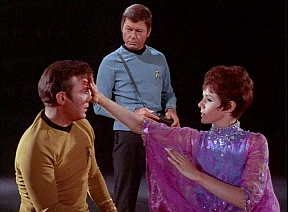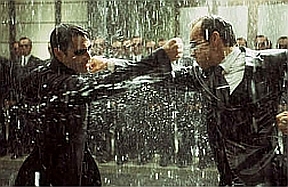Terror Has No Shape!
 A sarpashana, or poison eater, is an aggressive colony of disparate microbes that have mutated to excrete and survive within a protoplasmic medium. This creature appears to be a bulging, surging mass of blotchy, semi-transparent ooze. At rest, a sarpashana would just about fill a 125-cubic-foot container. It weighs approximately 1,400 pounds, but has it has enough bouyancy to swim clumsily. Its protoplasmic mass has sufficient cohesion and strength to climb up walls, but is still fluid enough to ooze through spaces no larger than the diameter of a adult’s little finger.
A sarpashana, or poison eater, is an aggressive colony of disparate microbes that have mutated to excrete and survive within a protoplasmic medium. This creature appears to be a bulging, surging mass of blotchy, semi-transparent ooze. At rest, a sarpashana would just about fill a 125-cubic-foot container. It weighs approximately 1,400 pounds, but has it has enough bouyancy to swim clumsily. Its protoplasmic mass has sufficient cohesion and strength to climb up walls, but is still fluid enough to ooze through spaces no larger than the diameter of a adult’s little finger.
As its name implies, a sarpashana survives by consuming toxins. It is especially attracted to the toxins produced by the metabolic processes of mammals. These include carbon dioxide, sulfates, nitrogen compounds, and phosphates. Using acute chemical sensors (roughly analogous to olfactory senses), a sarpashana detects its preferred foods. Devoid of anything resembling intelligence and always hungry, a sarpashana always moves toward the closest source of nourishment in order to feed. Unfortunately for mammals, a sarpashana’s preferred foods are found in vital places such as the kidneys, bladder, liver, lungs, and bloodstream.
A sarpashana attacks with a crushing lash by rapidly funneling a portion of its mass into a protoplasmic extension. The power of its lash is not main danger posed by a sarpashana. Rather, the creeping residue invariably left behind on the victim merits the greater amount of fear. This residue slithers rapidly on the victim, seeking ingress via whatever orifices are avaiable. Inside the victim’s body, the microbes burrow through soft membranes in order to enter the bloodstream, which then carries the microbes to those aforementioned internal organs richest in the creature’s preferred food. This can wreak horrible internal damage on the host.
Stars Without Number Stats
Armor Class: 6
Hit Dice: 3
Attack Bonus: +6
Damage: 1d10 protoplasmic lash
No. Appearing: 1d8
Saving Throw: 14
Movement: 20 ft.
Morale: 9
Swords & Wizardry Stats
Hit Dice: 3
Armor Class: 6 [13]
Attacks: Protoplasmic lash (1d10 + creeping residue)
Saving Throw: 14
Special: Immune to poison & weapons
Move: 9
Alignment: Neutrality
Challenge Level/XP: 6/400
Creeping Residue: Anyone struck by a sarpashana’s lash runs the risk of being invaded by slithering bits of microbe-laden protoplasm. A successful protoplasmic lash attack leaves behind 1d4 bits of creeping residue (a saving throw — Evasion or Luck for SWN players — avoids 1d3 bits). Each bit reaches a bodily orifice in 1d6 rounds. Removing a bit of creeping residue isn’t difficult, assuming it can be reached. (Bits that have slithered inside a victim’s armor may prove problematic.) Once within the victim, the infection goes to work. If the host dies, the microbes continue to feed and grow, producing a new sarpashana that oozes forth to hunt and feed.
Sarpashana Infection: (SWN) Toxicity 10, Interval 1d8 minutes, Virulence 3. At each interval, the victim suffers 2d4 points of damage. (S&W) Every 1d8 minutes, the victim must make a saving throw or suffer 2d4 points of damage. If the victim makes three successful saving throws before dying, his body’s natural defenses overwhelm and defeat the infection.
Immune to Poison & Weapons: A sarpashana cannot be easily harmed. It is completely immune to poisons. Likewise, most weapons cannot damage it (although they can splash microbe-filled gobs of protoplasm around). Conventional weaponry that relies on kinetic force (bullets, arrows, melee weapons, et cetera) do not damage a sarpashana. Those in melee range of a sarpashana when it is struck by such weapons may be splashed with creeping residue. A saving throw (an Evasion or Luck saving throw for SWN players) avoids being splashed with creeping residue.
Energy attacks (such as lasers and lightning bolts) and especially powerful weapons (such as high-explosive devices or a giant’s boulder) inflict normal damage on a sarpashana. Effects that specifically target pathogens are especially harmful to a sarpashana. Psionic powers or spells that cure disease inflict 1d6 points of damage per power/spell level (no saving throw). A medkit can be used against a sarpashana. The medic can deploy antibiotics (requiring an attack roll as adjudicated by the GM) to inflict up to 1d6 points of damage per Tech/Medical skill level.
 Empathy
Empathy The badlands world of Rigel presents several challenges to its population. The absence of indigenous life above the microbial level means that food must be either imported from off-world or grown locally from non-native stocks.
The badlands world of Rigel presents several challenges to its population. The absence of indigenous life above the microbial level means that food must be either imported from off-world or grown locally from non-native stocks. In Stars Without Number, the combat roll has a target number of 20+ on 1d20, subject to the following modifiers:
In Stars Without Number, the combat roll has a target number of 20+ on 1d20, subject to the following modifiers: